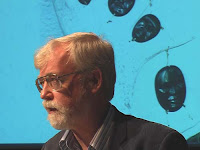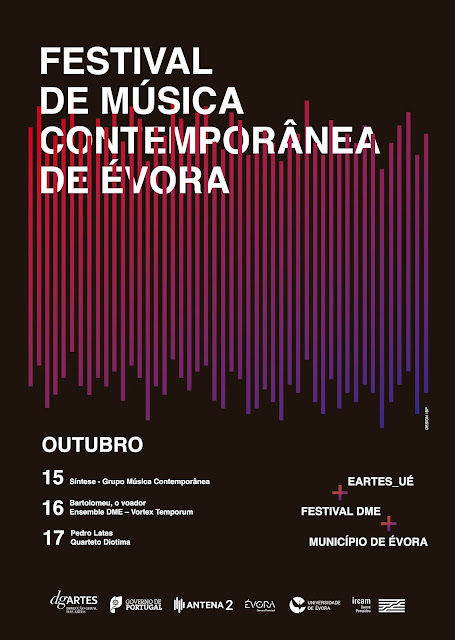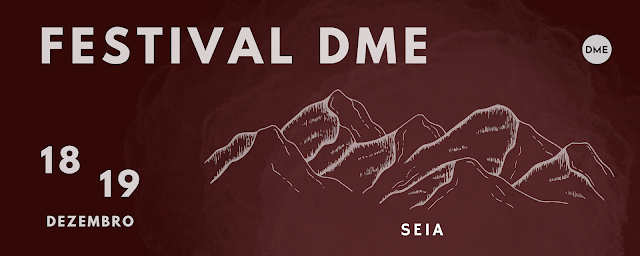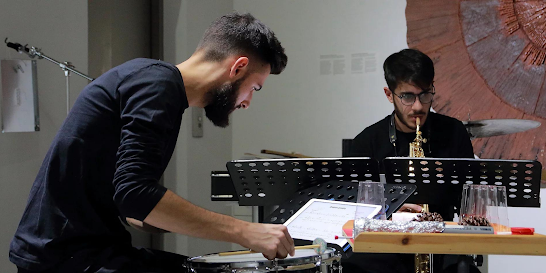DME 55 - Day 3
Program
Programa
October 27
19h - 19h45
Conference
Listening, Acoustic Space and Soundscape Composition
An epistemological model of sound is proposed involving information derived from the inner structure of sound as interpreted by the listener’s contextual knowledge. The most basic form of this form of communication occurs when the listener recognizes both a sound source and also the acoustic space in which it has been produced, thereby creating a direct and embodied orientation within that space. Today, listeners are frequently making sense of virtual soundscapes, often of their own choosing, that are embedded within their acoustic environment, thereby adding additional layers of complexity to their interpretation and interaction. Just as the concept of “soundscape” embraces all forms of sound and emphasizes how sound is understood by listeners, so too soundscape composition creates simulated environments of sound within which the distinctions between voice, music and environmental sound are blurred. In the author’s soundscape compositions, the sound material is elaborated using contemporary digital signal processing techniques while maintaining listener recognizability, and the structure of the work and its narrative are guided by the composer’s contextual knowledge of the real world. Sound examples drawn from the work of the World Soundscape Project at SFU and the author’s soundscape compositions will be featured.
Um modelo epistemológico de som é proposto envolvendo informação derivada da estrutura interna do som conforme interpretada pelo conhecimento contextual do ouvinte. A forma mais básica deste tipo de comunicação ocorre quando o ouvinte reconhece tanto uma fonte de som como também o espaço acústico em que foi produzida, criando assim uma orientação direta e incorporada dentro desse espaço. Hoje, os ouvintes procuram frequentemente um sentido para as paisagens sonoras virtuais, muitas vezes por sua escolha, que estão incorporadas no seu ambiente acústico, adicionando assim camadas de complexidade adicionais à sua interpretação e interação. Assim como o conceito de "soundscape" engloba todas as formas de som e enfatiza a compreensão do som pelos ouvintes, a composição de Paisagem Sonora cria igualmente ambientes simulados de som dentro dos quais as distinções entre voz, música e som ambiental são diluídas. Nas composições de Paisagem Sonora do autor, o material sonoro é elaborado utilizando técnicas contemporâneas de processamento digital de sinais, mantendo a capacidade de reconhecimento do ouvinte, e a estrutura da obra e da sua narrativa são guiadas pelo conhecimento contextual do compositor do mundo real. São apresentados exemplos de som do trabalho do World Soundscape Project na SFU e as composições de Paisagens Sonora do autor.
Audição, Espaço Acústico e Composição de Paisagem Sonora
Um modelo epistemológico de som é proposto envolvendo informação derivada da estrutura interna do som conforme interpretada pelo conhecimento contextual do ouvinte. A forma mais básica deste tipo de comunicação ocorre quando o ouvinte reconhece tanto uma fonte de som como também o espaço acústico em que foi produzida, criando assim uma orientação direta e incorporada dentro desse espaço. Hoje, os ouvintes procuram frequentemente um sentido para as paisagens sonoras virtuais, muitas vezes por sua escolha, que estão incorporadas no seu ambiente acústico, adicionando assim camadas de complexidade adicionais à sua interpretação e interação. Assim como o conceito de "soundscape" engloba todas as formas de som e enfatiza a compreensão do som pelos ouvintes, a composição de Paisagem Sonora cria igualmente ambientes simulados de som dentro dos quais as distinções entre voz, música e som ambiental são diluídas. Nas composições de Paisagem Sonora do autor, o material sonoro é elaborado utilizando técnicas contemporâneas de processamento digital de sinais, mantendo a capacidade de reconhecimento do ouvinte, e a estrutura da obra e da sua narrativa são guiadas pelo conhecimento contextual do compositor do mundo real. São apresentados exemplos de som do trabalho do World Soundscape Project na SFU e as composições de Paisagens Sonora do autor.
21h - 22h
Electroacoustics & Soundscapes #4
Bio
Barry Truax is a Professor Emeritus in the School of Communication (and formerly the School for the Contemporary Arts) at Simon Fraser University where he taught courses in acoustic communication and electroacoustic music. He worked with the World Soundscape Project, editing its Handbook for Acoustic Ecology, and has published a book Acoustic Communication dealing with sound and technology. As a composer, Truax is best known for his work with the PODX computer music system which he has used for tape solo works, music theatre pieces and those with live performers or computer graphics. In 1991 his work, Riverrun, was awarded the Magisterium at the International Competition of Electroacoustic Music in Bourges, France. Truax’s multi-channel soundscape compositions are frequently featured in concerts and festivals around the world. Since his retirement in 2015, Barry has been the Edgard Varèse Guest Professor at the Technical University in Berlin, and Guest Composer at the 2016 BEAST Festival in Birmingham.
Biografia
Barry Truax é Professor Emeritus na School of Communication, anteriormente a School for the Contemporary Arts na Simon Fraser University, onde leccionou cursos de comunicação acústica e música electroacústica. Trabalhou com o World Soundscape Project, tendo editado o Handbook for Acoustic Ecology, e publicou o livro Acoustic Communication que lida com todos os aspectos do som e tecnologia. Como compositor, Truax é mais conhecido pelo seu trabalho com o sistema PODX que utilizou para criar trabalhos a solo para fita magnética, peças de teatro-musical e obras que utilizem intérpretes ao vivo e gráficos de computador. A sua obra de 1991, Riverrun, foi galardoada com o Magisterium na International Competition of Electroacoustic Music in Bourges, France. As suas paisagens sonoras em multicanal são frequentemente apresentadas em concertos e festivais em todo o mundo. Entre 2015 e 2016, Truax foi o Edgard Varèse Guest Professor na TU de Berlim.
Biografia
Barry Truax é Professor Emeritus na School of Communication, anteriormente a School for the Contemporary Arts na Simon Fraser University, onde leccionou cursos de comunicação acústica e música electroacústica. Trabalhou com o World Soundscape Project, tendo editado o Handbook for Acoustic Ecology, e publicou o livro Acoustic Communication que lida com todos os aspectos do som e tecnologia. Como compositor, Truax é mais conhecido pelo seu trabalho com o sistema PODX que utilizou para criar trabalhos a solo para fita magnética, peças de teatro-musical e obras que utilizem intérpretes ao vivo e gráficos de computador. A sua obra de 1991, Riverrun, foi galardoada com o Magisterium na International Competition of Electroacoustic Music in Bourges, France. As suas paisagens sonoras em multicanal são frequentemente apresentadas em concertos e festivais em todo o mundo. Entre 2015 e 2016, Truax foi o Edgard Varèse Guest Professor na TU de Berlim.
Notes
Pacific Fanfare
Pacific Fanfare was composed to mark the 25th anniversary of both the Vancouver New Music Society and the World Soundscape Project at Simon Fraser University. It is comprised of ten soundmarks recorded by the WSP in the Vancouver area either from the early 1970s or more recently, and thus reflects the changing soundscape of the city. The various sound signals are heard both in their original state, and digitally resonated and time-stretched in order to let them "resonate" in our own memories.
Pacific Fanfare foi criada no âmbito do 25º aniversário da Vancouver New Music Society e da World Soundscape Project (WSP), na Simon Fraser University. É composta por dez fragmentos de som gravados pela WSP na zona de Vancouver, tanto no início dos anos setenta como também mais recentemente, reflectindo dessa forma as alterações na paisagem sonora da cidade. Os diversos sons são ouvidos tanto no seu formato original, como também digitalmente difundidos e expandidos no tempo, de forma a que “ressoem” na nossa memória.
Pacific Fanfare foi criada no âmbito do 25º aniversário da Vancouver New Music Society e da World Soundscape Project (WSP), na Simon Fraser University. É composta por dez fragmentos de som gravados pela WSP na zona de Vancouver, tanto no início dos anos setenta como também mais recentemente, reflectindo dessa forma as alterações na paisagem sonora da cidade. Os diversos sons são ouvidos tanto no seu formato original, como também digitalmente difundidos e expandidos no tempo, de forma a que “ressoem” na nossa memória.
Chalice Well
Chalice Well is a holy well situated at the foot of Glastonbury Tor in southwest England, thought to be originally the island of Avalon from Arthurian legend, and the site where Joseph of Arimathea placed the chalice known as the Holy Grail. According to legend, the Tor, a masculine symbol, is hollow underneath and the entrance to the underworld, guarded by the Grail. The well, on the other hand, is a symbol of the feminine aspect of deity, and its waters are believed to possess healing qualities.
This work Chalice Well takes the listener on an imaginary journey down into the well, passing through several cavernous chambers on its descent, filled with rushing and trickling water, including the chamber of the feminine spirit. The journey continues to the glass chamber, then to the gates of the underworld, only to be confronted by the image of the Grail, and finally coming to rest in the space where wind and water, the masculine and the feminine are combined.
Chalice Well transporta o ouvinte numa viagem imaginária pelas diversas caves e cavernas do poço, repletas de água, incluindo a câmara do espírito feminino. A viagem continua até uma câmara de vidro, continuando para as portas do submundo onde surge a imagem do Santo Graal, terminando no espaço onde o vento e a água, o masculino e o feminino, se fundem.
Earth And Steel
Earth and Steel takes the listener back to a time a century ago when large steel ships were built in enclosed slips, and rich metallic resonances rang out. These larger than life sounds reflected the sheer volume of the ships themselves that dwarfed those who were building them. However, just as the piece progresses and ends, these soundscapes now have become increasingly distant memories, only to be re-imagined in museums.
Earth and Steel transporta o ouvinte para o tempo quando grandes barcos de aço eram construídos em espaços resguardados, há um século, e ricas ressonâncias metálicas eram ouvidas. Estas grandes sonoridades reflectiam o volume abrupto dos barcos em si, que abafavam quem os construía. No entanto, à medida que a peça se desenvolve e termina, as paisagens sonoras tornam-se cada vez mais memórias distantes, apenas para serem re-imaginadas em museus.
Earth and Steel transporta o ouvinte para o tempo quando grandes barcos de aço eram construídos em espaços resguardados, há um século, e ricas ressonâncias metálicas eram ouvidas. Estas grandes sonoridades reflectiam o volume abrupto dos barcos em si, que abafavam quem os construía. No entanto, à medida que a peça se desenvolve e termina, as paisagens sonoras tornam-se cada vez mais memórias distantes, apenas para serem re-imaginadas em museus.
Ocean Deep
Ocean Deep takes the listener on an imaginary descent into the depths of the ocean in an immersible capable of withstanding the tremendous pressure of the undersea environment. We hear the creaking of its frame and encounter swarms of strange sea creatures. A strong vortical undercurrent propels the return ascent and we emerge back on the shore of a subtropical island in the evening.
Ocean Deep is an extension of the first movement of the author’s 1990 quadraphonic work Pacific, the first to use granular time stretching of environmental sound using the composer’s PODX software, with spatialization created by Harmonic Functions’ TiMax2 matrix mixer. The accompanying video was assembled by David Murphy from images created by the late Theo Goldberg, based on the famous Hokusai woodblock print, The Great Wave.
Ocean Deep conduz o ouvinte por uma descida imaginária ao fundo do mar numa cápsula construída por forma a suportar a pressão tremenda do ambiente subaquático. Ouvimos o estalar da sua estrutura e deparamo-nos com enxames de criaturas estranhas subaquáticas. Uma forte corrente vertical empurra-nos para a subida de regresso, onde emergimos de volta na costa de uma ilha subtropical à noite.
Ocean Deep é uma extensão do primeiro andamento de uma obra quadrifónica do compositor de 1990, Pacific, pioneira na utilização da expansão granular do tempo, relativo aos ambientes sonoros, através do uso do software do compositor, PODX, com espacialização criada por Harmonic Functions’ TiMax2 matrix mixer. O vídeo que a acompanha foi editado por David Murphy através de imagens criadas pelo já falecido Theo Goldberg, baseadas na famosa impressão em bloco de madeira de Hokusai, The Great Wave.
Ocean Deep conduz o ouvinte por uma descida imaginária ao fundo do mar numa cápsula construída por forma a suportar a pressão tremenda do ambiente subaquático. Ouvimos o estalar da sua estrutura e deparamo-nos com enxames de criaturas estranhas subaquáticas. Uma forte corrente vertical empurra-nos para a subida de regresso, onde emergimos de volta na costa de uma ilha subtropical à noite.
Ocean Deep é uma extensão do primeiro andamento de uma obra quadrifónica do compositor de 1990, Pacific, pioneira na utilização da expansão granular do tempo, relativo aos ambientes sonoros, através do uso do software do compositor, PODX, com espacialização criada por Harmonic Functions’ TiMax2 matrix mixer. O vídeo que a acompanha foi editado por David Murphy através de imagens criadas pelo já falecido Theo Goldberg, baseadas na famosa impressão em bloco de madeira de Hokusai, The Great Wave.
The Garden of Sonic Delights invites the listener to enter an imaginary soundscape (one that Murray Schafer might describe as a “soniferous garden”) richly filled with sounds that may remind us of the actual sounds of water, wind, insects, animals and birds. Our visit will take us through the afternoon until the next morning, hopefully leaving us delighted and refreshed.
The Garden of Sonic Delights convida o ouvinte a entrar numa paisagem sonora imaginária (uma que Murray Schafer poderia descrever como “jardim sonorífero”) repleta de sons ricos que nos lembram sons de água, vento, insectos, animais e pássaros. A nossa visita leva-nos desde a tarde até à manhã do dia seguinte, na esperança que nos deixe maravilhados e revigorados.
The Garden of Sonic Delights convida o ouvinte a entrar numa paisagem sonora imaginária (uma que Murray Schafer poderia descrever como “jardim sonorífero”) repleta de sons ricos que nos lembram sons de água, vento, insectos, animais e pássaros. A nossa visita leva-nos desde a tarde até à manhã do dia seguinte, na esperança que nos deixe maravilhados e revigorados.




Comentários